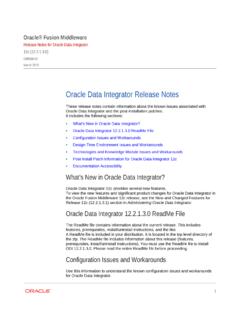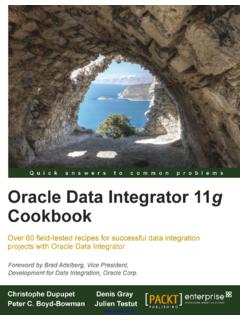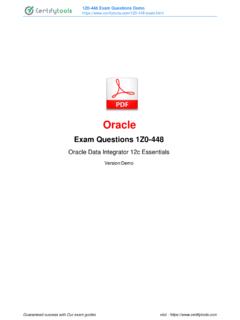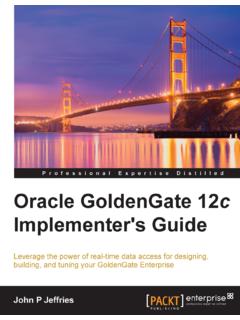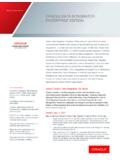Transcription of ORACLE DATA INTEGRATOR 11G: AUDIENCE INTEGRATION …
1 CENTER OF KNOWLEDGE, PATH TO SUCCESS Website: ORACLE data INTEGRATOR 11g: INTEGRATION and Administration | Page 1 of 3 300614 ORACLE data INTEGRATOR 11G: INTEGRATION AND ADMINISTRATION Duration: 5 Days; Instructor-led WHAT YOU WILL LEARN ORACLE data INTEGRATOR is a comprehensive data INTEGRATION platform that covers all data INTEGRATION requirements from high-volume, high-performance batch loads, to event-driven INTEGRATION processes and SOA-enabled data services. ORACLE data INTEGRATOR 's Extract, Load, Transform (E-LT) architecture leverages disparate RDBMS engines to process and transform the data - the approach that optimizes performance, scalability and lowers overall solution costs. This offering details on how to use ORACLE data INTEGRATOR (ODI) to implement high-performance movement and transformation of data among various platforms.
2 It also deals with usage of ODI graphical user interfaces that enable user to access different ODI components and resources that form ODI infrastructure. Using the graphical interfaces, you create and manage ODI repositories, which store configuration information about the IT infrastructure, the metadata for all applications, projects, models and other ODI artifacts. You also learn how to create the ODI Topology, organize ODI models and design ODI interfaces, procedures, packages and other objects. Learn To: Use ORACLE data INTEGRATOR to perform transformation of data among various platforms Design ODI Interfaces, Procedures, and Packages to perform ELT data transformations Administer ODI resources and set up security with ODI Learn to perform data INTEGRATION and transformation among various platforms.
3 Learn to use the ODI graphical interface to define procedures, packages, and ELT jobs. Learn to set up and maintain a secure, multi-user ODI environment. Implement Changed data Capture with ODI Use ODI Web services and perform INTEGRATION of ODI with SOA Benefits to You Improve performance and reduce INTEGRATION costs across your organization's heterogeneous systems. Centralize data across databases using your new skills to perform data INTEGRATION , design ODI interfaces, and setup ODI security. This course is based on ORACLE data INTEGRATOR 11g( ) AUDIENCE This course is specially design for Business Analysts, data Modelers, data Warehouse Administrator, Database Administrators, SOA Architect and Technical Consultant PREREQUISITES Suggested Prerequisites: Working knowledge of SQL Required Prerequisites Basic knowledge of ELT data processing METHODOLOGY This program will be conducted with interactive lectures, PowerPoint presentations, discussions and practical exercises COURSE OBJECTIVES Upon completion of this program, participants should be able to.
4 Describe ODI Model concepts Describe architecture of ORACLE data INTEGRATOR 11g Apply ODI Topology concepts for data INTEGRATION Design ODI Interfaces, Procedures, Packages, and Load Plans to perform ELT data transformations Explore, audit data , and enforce data quality with ODI Administer ODI resources and setup security with ODI Implement Changed data Capture with ODI Use ODI Web services and perform INTEGRATION of ODI with SOA COURSE OUTLINE Module 1 - Introduction Identifying the Course Units What is ORACLE data INTEGRATOR ? Why ORACLE data INTEGRATOR ? Overview of ODI 11g Architecture Overview of ODI 11g Components About Graphical Modules Types of ODI Agents Overview of ORACLE data INTEGRATOR Repositories Module 2 - Administering ODI Repositories and Agents Administrating the ODI Repositories Creating Repository Storage Spaces Creating and Connecting to the Master Repository Creating and Connecting to the Work Repository Managing ODI Agents Creating a Physical Agent Launching a Listener, Scheduler and Web Agent Example of Load Balancing ORACLE data INTEGRATOR 11g.
5 INTEGRATION and Administration | Page 2 of 3 300614 Module 3 - ODI Topology Concepts Overview of ODI Topology About data Servers and Physical Schemas Defining the Physical Architecture Defining the Logical Architecture Mapping Logical and Physical Resources Defining Agents Defining a Topology Planning the Topology Module 4 - Describing the Physical and Logical Architecture Overview of Topology Navigator Creating Physical Architecture Creating a data Server Testing a data Server Connection Creating a Physical Schema Creating Logical Architecture Overview of Logical Architecture and Context Views Linking the Logical and Physical Architecture Module 5 - Setting Up a New ODI Project Overview of ODI Projects Creating a New Project Using Folders Organizing Projects and Folders Understanding Knowledge Modules Exchanging ODI Objects and Sharing Global Objects Exporting and Importing Objects Using Markers Module 6 - ORACLE data INTEGRATOR Model Concepts What is a Model?
6 Understanding Metadata in ODI Understanding Reverse Engineering Creating Models Organizing Models Creating data stores Using Constraints in ODI Creating Keys and References Module 7 - Organizing ODI Models and Creating data stores What is an Interface? Business Rules for Interfaces What is a Mapping? What is a Join? What is a Filter? What is a Constraint? What is a Staging Area? Creating a Basic Interface Module 8 - ODI Interface Concepts What is an Interface? Business Rules for Interfaces What is a Mapping, Filter, Join? Overview of INTEGRATION Process What is a Staging Area? About Execution Location Using Knowledge Modules (KM) with ODI Interface Creating a Basic Interface Module 9 - Designing Interfaces Designing an Interface Multiple Source data stores Creating Joins Filtering data Disabling Transformations Overview of the Flow Specifying the Staging Area Selecting Knowledge Modules Module 10 - Interfaces: Monitoring and Debugging Monitoring Interfaces Using Operator Viewing Sessions and Tasks How to Monitor Execution of an Interface How to Troubleshoot a Session Keys to Reviewing the Generated Code Working with Errors Tips for Preventing Errors Module 11 - Designing Interfaces.
7 Advanced Topics Using Business Rules in Interfaces Overview of Business Rule Elements Using and Tracking Variables Using User Functions Using Substitution Methods Modifying a KM Showing Variable Values in Log Using RKM for Customized Reverse Engineering Module 12 - Using ODI procedures What is a Procedure? Examples of Procedures Creating Procedures Adding Commands Adding Options Running a Procedure Using Operator to View Results Module 13 - Using ODI Packages What is a package? Creating a package Executing a package Creating Advanced Packages Error handling Controlling an Execution Path Creating a Loop Using the Advanced tab Module 14 - Managing ODI Scenarios and Versions What is a Scenario? Managing Scenarios with Load Plans Preparing Scenarios for Deployment Automating Scenario Management Scheduling the ODI Scenario Overview of ODI version management Using Version Browser and Version Comparison Tool Handling concurrent changes ORACLE data INTEGRATOR 11g: INTEGRATION and Administration | Page 3 of 3 300614 Module 15 - Enforcing data Quality and Auditing data with ODI Why data Quality?
8 When to Enforce data Quality? data Quality in Source Applications data Quality Control in the INTEGRATION Process data Quality in the Target Applications Enforcing data Quality Exploring Your data Auditing data Quality Module 16 - Working with Changed data Capture Overview of ODI version management Techniques of Changed data Capture Changed data Capture in ODI CDC Strategies and Infrastructure CDC Consistency Using CDC Viewing data /Changed data Using Journalizing Module 17 - Administering ODI Resources: Advanced Topics Using Open Tools Installing Open Tools Using Open Tools in a Package Using Open Tools in a Procedure or in a KM Developing Your Own Open Tools Setting Up ODI Security Defining Security Policies Defining Password Policies Module 18 - Using Web Services and INTEGRATION of ORACLE data INTEGRATOR with SOA Web Services in Action Using data Services Setting Up data Services Testing data Services Installing Public Web Services Using Public Web Services Invoking Web Services Integrating ODI with SOA Module 19 - Extending ODI with the SDK Using SDK Public Interfaces Integrating through ODI SDK Examining SDK examples

